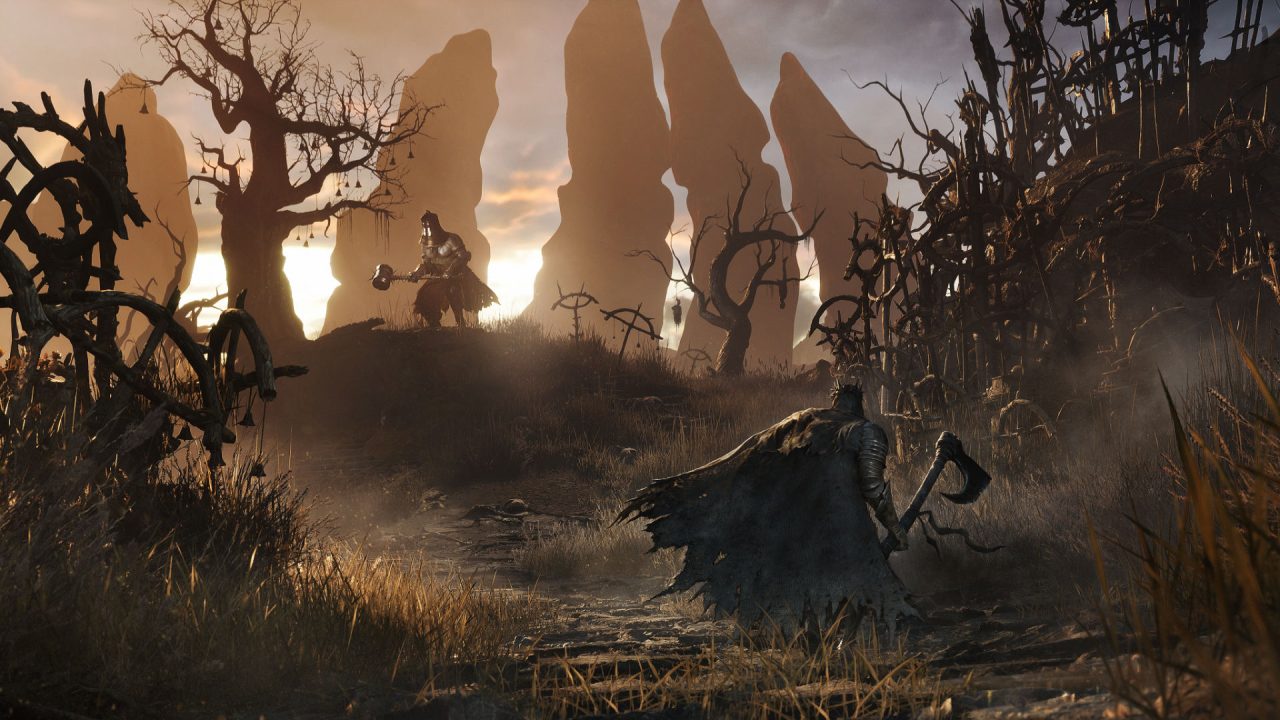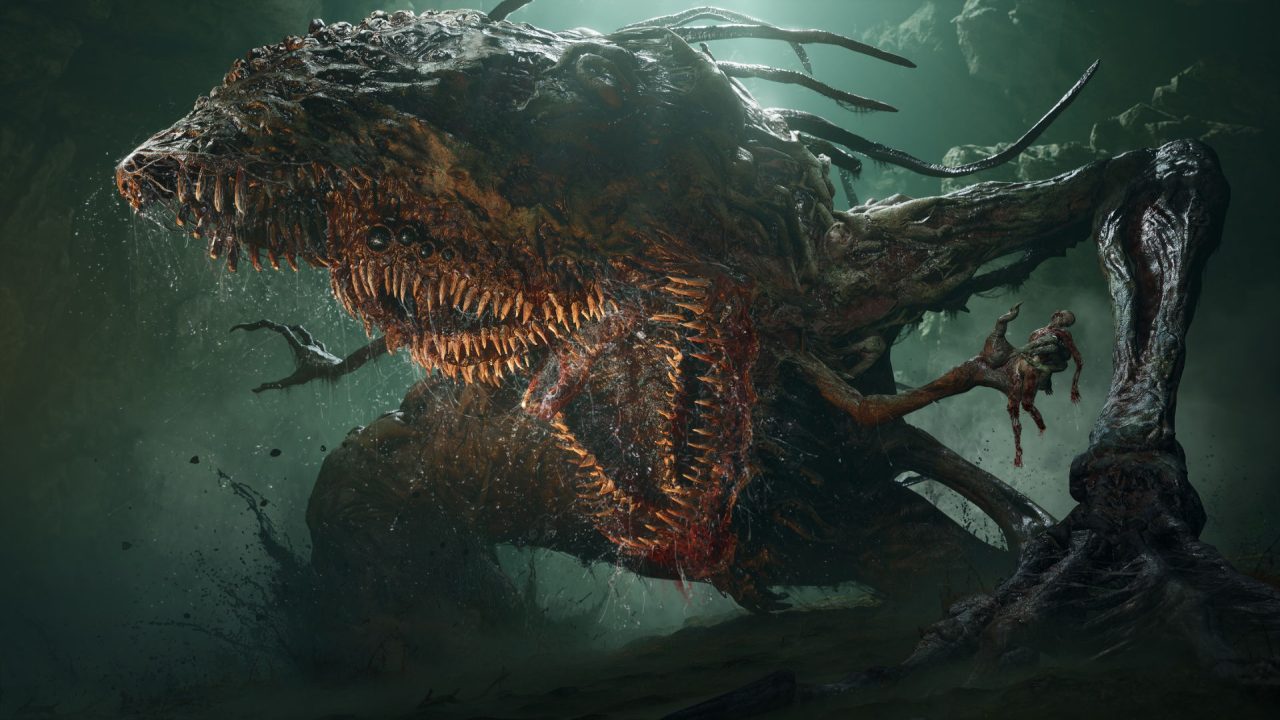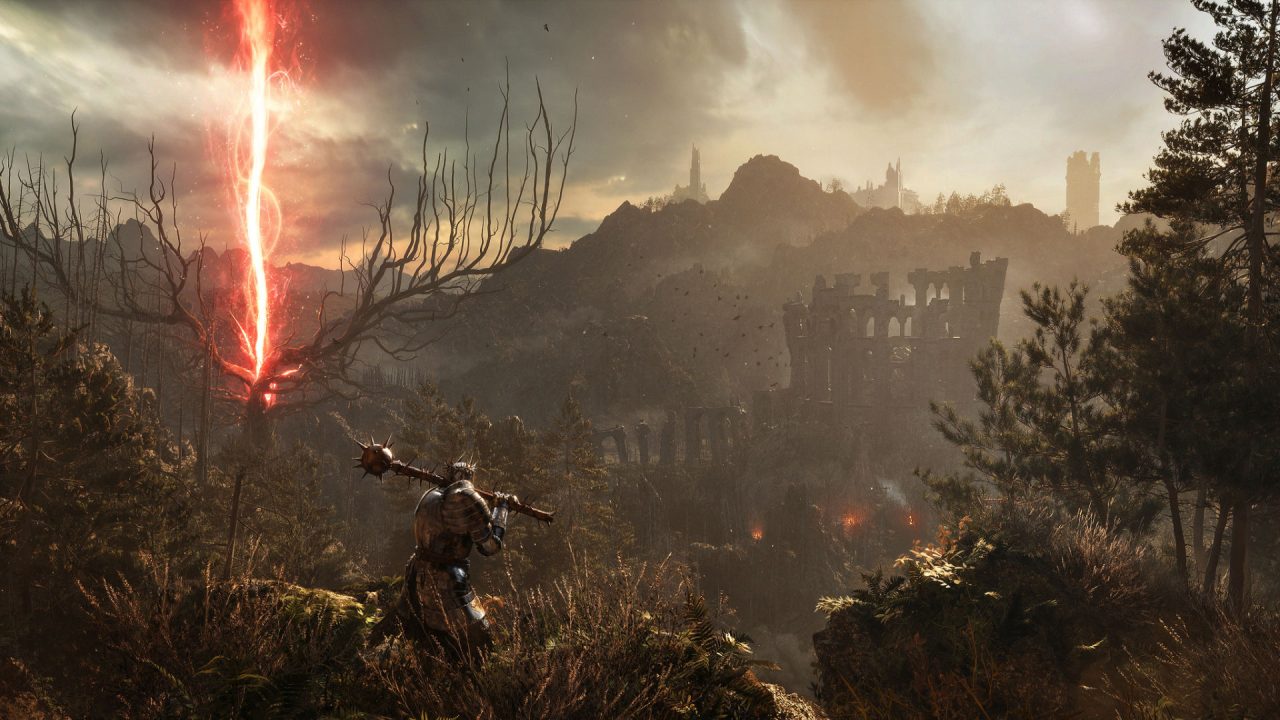Few games wear their inspiration on their sleeves quite as proudly as Lords of the Fallen. Creative director Cezar Virtuoso even went so far as to call the game “Dark Souls 4.5”. While it doesn’t quite hit the high marks of Miyazaki’s extensive catalog, Lords of the Fallen is nonetheless a valiant effort in the sea of soulslikes.
Anyone versed in FromSoftware’s library (or any of the millions of soulslikes that followed it) will immediately feel at home in Lords of the Fallen. Gritty third-person combat full of dodging, parrying, and posture-breaking, an esoteric world requiring players to do most of the heavy lifting to fill in the gaps, and of course, a healthy selection of bosses to test your mettle. Thankfully, Lords of the Fallen isn’t so brazen as to simply copy the formula without adding its own spin, but not without its share of blunders.
Among these is one of the game’s most notable additions, the dual realm system of Axiom and Umbral. Axiom is the standard physical world where you are likely to spend most of your playthrough. Underneath it lies Umbral, the realm of death, where enticing rewards and formidable foes await. You can either peek into Umbral or enter it entirely through the lamp that you carry with you at all times. Otherwise, dying in Axiom will also transport you to Umbral as a second life. Either way, once you’re in, the only way to return to the land of the living is to interact with specific totems scattered throughout the map.
In theory, this system is a brilliant way of extending exploration without bloating the size of the world. Broken bridges and sheer cliffs in Axiom often have analogous areas to explore in Umbral, while a selection of Umbral-exclusive elite enemies and gradually scaling spawn rates keep you from being too comfortable there. Some notable changes in combat occur in Umbral with “wither.” Enemies in Umbral generally “wither” your health first, turning it gray instead of deleting it entirely, giving you a chance to regain that health by striking enemies before they can hit you again. Fans of Bloodborne will recognize this as the “rally” mechanic, but the caveat is that roughly half of any health you gain from items are withered first, pressing the issue of aggressive combat in Umbral arguably more than even Bloodborne.
In practice, Umbral felt underdeveloped and tacked on. For one, the lamp as a whole feels a bit useless. In terms of combat, you can “soulflay” certain enemies to briefly stun them and wither their health. While this sounds mighty practical, the comically long wind-up to soulflaying combined with the extremely quick recovery of enemies after the stun oftentimes makes this move more trouble than it’s worth.
Peeking into Umbral with the lamp is almost entirely worthless outside of a handful of situations where you have to phase through an obstacle or two. Any meaningful loot found in Umbral has you yanking it out of a corpse first, which requires you to fully transition realms before doing so. The encounter design hampers opportunities to peek into Umbral at bridges or little cliffs you might want to peek over before diving in. You’re better off just entering Umbral before running to the places you want to explore unless you want to tediously clear all the Axiom enemies first before encountering hordes of mobs in Umbral anyway.
Speaking of encounter design, Lords of the Fallen takes the worst pages out of Dark Souls II‘s chapter on this matter and treats it as gospel on the regular. Enemies will always aggro in groups with even the most careful baiting techniques, and often these groups will be a well-rounded army of melee, ranged, and trash mob units. The deeper into the game you go, the more obnoxious these encounters become, often containing multiple elite enemies previously encountered as separate boss fights. At times like these, it feels like the developers don’t want you to play the game as much as they want you to die.
Even in the few fleeting moments where you avoid the threat of death at every opportunity, there is plenty of other nonsense sprinkled in. Enemies that exist to just push you off a cliff, zombie trash mobs that randomly deal 40% of your HP in one weak-looking strike, and enemy attacks with so much horizontal momentum they fly at you like a Call of Duty commando lunge are just some of the jank and frustration you can expect to endure during your playthrough.
Enemy variety leaves something to be desired. The previously mentioned age-old RPG trope of introducing old bosses as regular elite enemies is incredibly overdone in Lords of the Fallen. Sometimes the game doesn’t even wait an entire area to reintroduce bosses as enemies, utterly failing to deliver the sense of player progression the trope is based around. If anything, exchanging their large HP pools for an army of supporting units made their post-boss encounters even more difficult to deal with, deflating whatever good feelings I had about beating the boss to begin with.
This also begins to seriously dull the combat past the midway point, as there is no variety in the enemies you face. I was frankly flabbergasted to discover that the final few areas of the game introduced a grand total of one new enemy type while the rest were from twenty to thirty hours earlier in my playthrough. How many times am I going to have to fight this dual-wielding axe monster from literally the very first area? In Lords of the Fallen, until the credits roll.
The silver lining in all this is that the combat is monstrously fun otherwise. Melee weapons have a certain weight and heft to them that makes landing blows supremely satisfying, with charged heavy attacks in particular feeling incredible. Quick-stepping for the first dodge while you’re locked on instead of rolling everywhere is also a great change of pace, borrowing right from Bloodborne. This simple change transforms the few one-on-one encounters into calculated duels instead of the “headless chicken rolling for dear life” kind of gameplay titles like Dark Souls III and Elden Ring sometimes devolved into. It’s just a shame that it’s difficult to appreciate this feature outside of boss fights.
Physical ranged damage has received a much-needed overhaul, no longer requiring you to purchase thousands of arrows and throwables for a dedicated build. Instead, you rely on universal ammo to fire and throw the different types of projectiles you pick up throughout the world. The best part about this is that you can restock by resting at vestiges (Lords of the Fallen’s version of bonfire checkpoints) or with a fairly cheap consumable. This is honestly my personal highlight of all the changes. It not only opened up an entire new avenue of gameplay for my melee build but also stoked my excitement for new builds to try out in later playthroughs.
Lords of the Fallen’s handling of build variety and leveling also deserves praise. Stats are neatly consolidated, with vitality boosting your maximum equipment load as well as HP. The two magic-based stats, Inferno and Radiance, simultaneously upgrade your mana pool and their respective damage types. Melee damage for agility and strength seems to scale incredibly well with even a meager B+ scaling on my weapon of choice, receiving respectable damage bumps even after investing over 50 levels into strength. Weapons unlock separate rune sockets as you upgrade them, allowing for greater customization, but the variety of runes is somewhat lacking. The general pace of Lords of the Fallen also allows for steady progression without resorting to tedious experience farms even approaching level 100. This includes upgrading a weapon or two to their highest level and purchasing anything that might strike your fancy from various vendors around the world.
Boss fights in Lords of the Fallen boast several changes for the better. Aesthetically speaking, there is a great amount of variety to be found, from the usual knights in heavy armor to hulking monsters that are a horrifying spectacle to behold. The non-humanoid fights, in particular, play incredibly well (unlike what can be said for many of FromSoft’s attempts) due to the various improvements developer Hexworks have made to the camera specifically for these situations. Arena-wide pan-outs and dynamically erasing certain body parts from view if they conceal your character are some of the improvements you can look forward to in these fights.
Gameplay-wise, the bosses as a whole were on the easier side for better and for worse. While they are exceedingly fair with well-telegraphed attacks and ample openings, most of them are too slow to pose a threat to all but the most hotheaded players. Once I got into the general gameplay rhythm, I was able to best all but one in two to three tries. Most Souls veterans can probably expect a similar experience, and I imagine even newcomers to the genre won’t die more than a handful of times when facing them.
Map design is another strength of Lords of the Fallen, mimicking Dark Souls I better than most of the later FromSoft titles. Hexwork’s effort to connect everything physically back to the central hub is admirable and makes the world much more enjoyable to explore. Despite each level having only one or two permanent vestiges for you to rest at, the smart vertical design ensures you can always return fairly easily. Additionally, players can create their own temporary checkpoints throughout the level at designated points using a special consumable. In terms of pure traversal, Lords of the Fallen easily slots into the upper echelon of soulslikes. However, the shortcuts are often of questionable quality, as they don’t circumvent the encounters you initially slogged through to unlock them. Rather, they beeline you straight into other tough enemies, almost missing the point entirely of having shortcuts.
Aesthetically speaking, the landscape of Lords of the Fallen is beautiful but uninspiring. When looking at the game in terms of graphical fidelity, it is top-notch. The issue is that it can’t quite shake the look of an Unreal Engine 5 tech demo. It lacks an inspired creative direction outside of the opening few areas to make the landscape truly stand out and puts in no effort to distinguish its visuals from the first things that come to mind when you think of “dark fantasy.” Umbral was the opportunity for some truly unique visuals, but it ends up painting the world in a vaguely Lovecraftian hue of blue with no further changes.
Even the game’s setting is as generic as it gets. The nation of Mournstead finally triumphs over Demon Lord Adyr, only for the seals holding back his return to have become corrupted several centuries later. Your job throughout the game is to deal with this crisis in whatever ways you see fit and face the consequences of your actions at the end of the game. Item descriptions full of lore could mend the uninspired nature of the setting, but these blurbs are oddly locked behind Radiance and Inferno requirements (and pretty steep ones, might I add). As much as I wanted to better understand the world of Mournstead, Lords of the Fallen gave me very few avenues to do so in my first playthrough.
But all of this brings us to the biggest stinker: performance. During my first few days with the game, Lords of the Fallen was borderline unplayable. An RTX 3070 with an AMD Ryzen 5 5600X could barely cough out 60FPS on medium settings and would regularly become a slideshow not even an hour into a session. Normally, this would be enough to not recommend the game, but the developers were quick to release a series of patches before the actual launch to dramatically improve performance. I can’t attest to how well these fixes have adjusted performance for the recommended specs on the Steam page, but on my rig, it’s stable enough to maintain 60fps at 1080p most of the time on high settings.
At the end of the day, Lords of the Fallen is a fun but oftentimes frustrating experience. The level design and combat adjustments are spot on, but extremely haphazard enemy placement and poor variety mar the experience. The game is beautiful yet dull to look at, with very few standouts in its grimdark landscape. It never quite manages to become more than the sum of its parts, but those parts had their fun moments all the same. I hope Hexworks can take everything they did right this time around and iterate further with their next release to make a truly stand-out soulslike title because the pieces for a home run are here in Lords of the Fallen.





